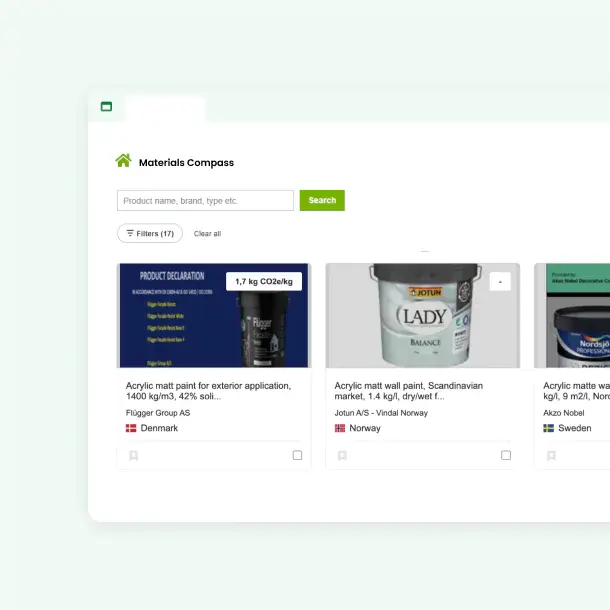
This article explains One Click LCA's production of residual mix of electricity data for European countries, which includes environmental impact indicators for scope 2 calculations under the Greenhouse Gas Protocol. By sourcing reputable data, using advanced modeling software, and ensuring rigorous quality checks, One Click LCA provides accurate, regulation-compliant data for various standards and certifications.
What is residual mix of electricity data?
One Click LCA produces residual mix of electricity data for European countries that can be easily used in scope 2 calculations and reporting based on the Greenhouse Gas Protocol.
The residual mix of electricity for a country represents the share of the electricity supply for which the energy source is not verified by guarantees of origin or other reliable tracking mechanisms. This mix is based on the fuel sources remaining after all claims on specific energy generation have been accounted for. Renewable energy sources are generally verified more extensively than other sources, so the residual mix typically contains a higher share of high-carbon fuels like coal and gas than the grid average mix. Consequently, the emission factors of the residual mix are usually higher than those of the grid average mix.
Why One Click LCA produces residual mix of electricity data
At One Click LCA, we understand that you need high-quality energy data to complete the life-cycle assessments (LCA) for your project. One Click LCA produces reliable, consistent, and current energy data to make LCA easier for you.One Click LCA's customers require residual mix of electricity data for European countries for scope 2 calculations and reporting based on the Greenhouse Gas Protocol.
While industry sources provide residual mix of electricity data, it is typically reported as Global Warming Potential (GWP) only, which is not accepted by most regulations or certifications and cannot be used in most One Click LCA tools. One Click LCA’s residual mix electricity data addresses this challenge. By performing its own calculations, One Click LCA enables broader usability of residual mix of electricity data by including environmental impact indicators as required by all regulations and standards.
How One Click LCA creates residual mix of electricity data
The residual mix of electricity composition, i.e. the quantity of every fuel or energy source used in forming the respective mix, is obtained from reputable and publicly available data providers, such as the Association of Issuing Bodies (AIB).
One Click LCA models underlying processes and elementary flows using generally available or customized life-cycle inventory (LCI) data.
Residual mix of electricity data is modeled using state-of-the-art software for energy LCA. It undergoes a rigorous quality assurance process before publication, including automated benchmarking against existing datasets in the world’s largest construction LCA database.
One Click LCA's step-by-step process
When producing energy data at One Click LCA, the company follows a rigorous four-step process to ensure quality, accuracy, and transparency.
1. Sourcing upstream and quantitative data
One Click LCA begins by acquiring quantitative data for the residual mixes of electricity. This source data is obtained from reputable and publicly available data providers, such as the Association of Issuing Bodies (AIB).
Below is a screenshot of AIB's report on several country-specific residual mixes of electricity.
.png?width=541&height=220&name=image%20(44).png)
Figure 1: Source: AIB report, https://www.aib-net.org/sites/default/files/assets/facts/residual-mix/2022/AIB_2022_Residual_Mix_Results_inclAnnex.pdf
2. Modeling with energy creation software
The modeling process for residual mix of electricity data starts with selecting the appropriate fuels or energy sources from a specially modified version of the upstream life-cycle inventories. One Click LCA then calculates the residual mixes of electricity using the Energy LCA profile tool (for internal use only) and makes it available for customer use.
From figure 1, you can see that for each residual mix of electricity, there is a share of the electricity produced by each specific fuel that adds up to 100%. For “unspecified” fuels, experts at One Click LCA make educated assumptions about what fuel it most likely represents.
For modeling, One Click LCA uses generally available life-cycle inventories for underlying processes and flows with a few customizations. The first addition is the voltage transformation burden, which is added to the original dataset. Transmission burdens are obtained from the IEA and World Bank and their DataBank World Development Indicators.
The second addition is direct emissions (smokestack emissions), which are necessary for producing residual mixes of electricity data but are not part of the standard EN15804 +A1/+A2 data arrays. This data is sourced and added separately from the emission factors database EFDB 2020, issued based on IPCC 2006 Guidelines.
Calculations ensure that the final result in One Click LCA energy models has the full array of emission factors for the impact indicators covered in the standards EN15804 +A1 and +A2, as well as other specific certification schemes and PCRs such as the International EPD system, INIES France, and TRACI for the US.
3. Review and internal verification process
The LCA data expert responsible for modeling the specific residual mix of electricity data in question is supported by a team of experienced peers throughout an internal quality assurance process to ensure model accuracy, rigidity, and integrity.
First, the model and resulting environmental impacts are reviewed as a stand-alone case to verify calculation logic and completeness of data. The expertise of the LCA data team at One Click LCA is critical in ensuring the high quality and reliability of this manual review and verification phase.
Second, the resulting environmental impacts are benchmarked against other similar energy data, both from the country in question and with source data from other calendar years and residual mix of electricity data for other countries.
4. Publishing and availability
Once the review process is complete and data quality has been confirmed, the residual mix of electricity data is published and becomes available in the One Click LCA database. You can now find the data in the software for both design, construction, and manufacturing.
In most cases, One Click LCA residual mix of electricity data includes environmental impact indicators as required by all regulations, standards, and Green Building Councils (GBC) across the world so you can find it in most of the tools globally, subject to the specific rules applicable to the use of residual mix of electricity data in the tool in question.
One Click LCA energy data typically includes environmental impacts for standards EN 15804+A2, EN 15804+A1, TRACI, ISO 14040, ISO 14044, and ISO 21930. It also typically includes additional indicators as required by specific Product Category Rules (PCR) and EPD programs globally, including International EPD System, INIES France, Boverket Sweden, and EPD Norge.
Can I request One Click LCA to add residual mix electricity data needed in my LCA projects?
Yes. You can contact the Customer Success team at One Click LCA to request integration of the new residual mix of electricity data that you need in your LCA projects.
Please note, though, that One Click LCA will evaluate and prioritize such integration based on the needs of its global customer base. You can also make the data integration order via your support services subscription to ensure timely delivery. This is a paid service, and the team is happy to assist you with details and options.
Please also bear in mind that in any case, the expert LCA data team will need to assess if it is possible to fulfill your request, as not all requests can be completed.
If you have specific data you wish to use, you can also add it directly to your company account via the user interface as private data. This feature is available to all expert license users, and the instructions on how to create private data can be found on the One Click LCA Help Centre.
Why are the environmental impacts of One Click LCA residual mix of electricity different from the data reported by AIB? Why don't you integrate data directly from the AIB report?
Data reported by AIB is available in the One Click LCA platform, in parallel with the residual mixes of electricity data calculated by One Click LCA with AIB as a quantitative data source. It is important to understand that AIB reports direct GWP kgCO2/kWh data only, which limits its usability and applicability. Depending on your needs, you can choose which data best suits you.
GWP-only data, as reported by AIB, is not accepted by most regulations or certifications and hence can’t be used in most of the One Click LCA tools either. One Click LCA residual mix of electricity data overcomes this challenge. By making its own calculations, One Click LCA enables broader usability of residual mix of electricity data by including environmental impact indicators as required by all regulations and standards.
Please note that residual mix of electricity data impacts as reported by AIB and One Click LCA are somewhat different. The probable cause for this is that there is some variation in the calculation methods and assumptions used by AIB and One Click LCA, respectively. This document describes data sources and calculation methods applied by One Click LCA, such as adding direct emissions to the upstream life-cycle inventories used to model the residual mixes of electricity data.
Find, compare & choose low-carbon construction materials
The Materials Compass from One Click LCA is designed to help construction professionals cut carbon in their projects & achieve sustainability goals by finding, comparing, and choosing the most sustainable building materials.

Carbon Experts Newsletter
Industry news & insights — straight to your inbox
Want to learn more?
Vesna Medic • Aug 01 2024
Jani Tierala • Aug 02 2024
Asha Ramachandran • May 23 2025
Panu Pasanen • Jan 19 2023
